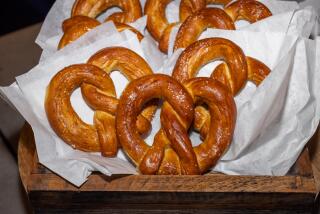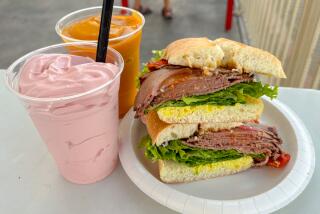Great Airline Food: Why It Won’t Fly
- Share via
On a recent weekday morning, Carmine Maffei, executive chef at United Airlines’ San Francisco kitchen, cooked up a mushroom souffle using chanterelles and porcini. “It was great,” Maffei says. “You should have tasted it. Like a three-star restaurant.” He beams.
But will the souffle make it to in-flight service? Maffei shrugs. First he must determine whether the souffle can be prepared half a day in advance and held in refrigerated suspension (below 45 degrees, by federal law) without spoiling. Then he’ll have to see whether it looks and tastes good after it’s reheated. And he’ll have to find out exactly what happens to a souffle at 30,000 feet.
Most important, the souffle will have to be approved by United’s executives. The main question they’ll ask: Is the souffle easy enough to make and cheap enough to warrant adding to the menu?
It’s easy to make fun of airline food. It’s not easy to cook it. Airline kitchens work under enormous handicaps.
Start with scale. United, the only domestic airline that operates its own kitchens, prepares 50,000 meals a day--in California alone. There are two kitchens in San Francisco and another in Los Angeles. Its 13 other kitchens, at airports scattered around the country, prepare a total of 80,000 more meals a day. Other airlines contract with one of a dozen caterers, all of whom operate on the same scale.
An in-flight kitchen--which is usually a warehouse located near a major airport--looks like a scene out of a Paul Bunyan story. Stock pots are the size of bathtubs. Each refrigerator is the size of a living room--with doors on each end. The grills can accommodate 40 steaks at the same time. The pantry is filled with barrels of oil, flour, salt and sugar.
Despite the quantities, airline caterers start with very good ingredients: The steaks are aged, the seafood is fresh, the berries are ripe. “We’re shooting for fresher foods,” says Wolfgang Erbe, Caterair’s executive chef for Alaska Airlines, who has been known to don kitchen whites and walk through airplanes asking people how they would improve the food. “When fresh seafood is available, we demand it. Our vegetables are fresh almost all the time.”
Erbe says that a decade ago more than half the products used by airlines were packaged, but that these days no more than 10% of the products served on board are canned. Still, the scale puts limitations on what can be done with the food; there’s no time for the kind of careful cooking you’d find in a restaurant. Recipes have to be simple enough to fit into an assembly-line setup.
Some of the stations actually look like factories, with conveyor belts running through them. Trays come by: One worker plops on lettuce, another a handful of sliced ham, a third some cheese. A fourth adds the packets of mayonnaise and mustard.
Meals are assembled at movable stations. As soon as the food is ready for a flight, the stainless-steel prep station is rolled away, the area is cleaned and a new line is set up.
The in-flight kitchen operates around the clock, and at peak hours it is jammed with cooks, tray assemblers, cleaning people and in-flight food storage boxes. When they’re full, the food storage boxes are moved into refrigerated cold rooms (38 degrees) to await the arrival of the plane that they are destined for.
Now consider timing: It generally takes between 12 and 24 hours for an airline meal to get from the assembly station to a passenger’s pull-down tray. During these hours the food is kept just above freezing. Bread stales under refrigeration, tomatoes lose flavor, lettuce wilts. Even when the food leaves the refrigerator room, it must still be kept cold; catering firms use a lot of dry ice between the kitchen and the airplane.
Incoming flights are cleared for landing about 15 minutes before they arrive at the gate. As soon as clearance is given, liaison personnel in the kitchen start loading the cold boxes full of dinners onto large catering trucks, which then head onto the freeway for the 10-minute drive to the airport.
How many meals are needed is determined by the flight’s passenger list, which is compiled 24 hours before it takes off. Since the airlines must, by law, discard any meals not eaten on board, they try not to load too many meals that won’t be eaten. Still, they always add a few extra dinners to accommodate “go-shows” or last-minute passengers.
When they get to the airport, the trucks go right onto the runway. They have specially designed beds that can be raised to the level of the plane’s galley door; the full carts are simply rolled in while those filled with refuse from the previous flight are rolled onto the truck. Waste removed from flights is returned to the caterer, sterilized in a huge pressurized heating tank (much like a giant autoclave) and then taken to the dump. (Federal law mandates that all airline waste products be sterilized before they are thrown out.)
Even airline officials admit that all this holding and moving takes its toll on the food. “When you’re late getting home from work and you call your wife to keep the food in the oven for an extra hour, how does it taste?” asks Carl Baber, head of Alaska Airlines food service.
A few executives, however, try to place the blame elsewhere. “Let’s face it,” says one airline food executive. “We cook it and it’s good, but once it leaves our kitchen and it’s in the hands of a flight attendant, who can overcook it--well, anything good can be ruined.”
Still, things are better today than they used to be, thanks to better ovens and better assembly and cooking techniques. One trick, developed over the past few years, is to partially cook foods, chill them and then complete the cooking just before flight time or on board the airplane. Industry food executives say this makes dishes taste fresher.
On larger planes with cooking units, food is boarded chilled and then heated in either a high-temperature forced-air convection oven or on a hot pad. Food for planes not equipped with ovens is heated before it leaves the kitchen and kept in a hot-box on the airplane until it is served. Such meals sit on special thermal trays that keep the food at a safe temperature for three hours.
United has developed a way to keep hot and cold food in the same cart. Each tray has a hole cut in it to accommodate the rectangular entree dish; when the tray is pushed into the cold cart, the entree dish slides onto a heating plate. United calls these their “new-tech” carts.
But no matter how high-tech the hardware, ultimately the airlines are restricted by the conventions of taste. Airline food has to appeal to a broad clientele. One airline food executive says that most larger airlines don’t have the courage to make truly distinctive food for fear that few will like it. Alaska Airlines, one of the most innovative, has taken the bold step of adding game meat--duck and venison--to its menu. But one excellent rabbit dish never made it into the air. The reason: Company executives feared a backlash from people with pet bunnies.
Although Americans are loath to eat the unusual, there are some ways in which our tastes have changed. “We do food research among our customers,” says Kathleen Boyd, director of product development for Continental Airlines, “and we’re finding that people are more aware of nutritional and health values. In the past, we’d look at what the other guys were doing, but today we’re listening to our customers more and listening to each other less.”
Airlines still offer breakfasts of sausages and eggs, but now there are often alternate breakfasts such as hot and cold cereals, yogurt, fresh fruit, a fresh bread product.
Lunches and dinners focus more on lighter foods, especially Italian food with more skinless chicken in lighter sauces, and seafood. Most airlines are using more seafood and less beef, more salads and pasta and less cream and flour-thick sauces.
“Our specs used to say shortening,” says Charlie Doherty, Delta’s director of dining service. “Now they say soybean oil. And we’re serving oat bran muffins in place of croissants.”
Still, none of the airlines interviewed would give a specific figure on the nutritional value or the fat and calorie count for their meals. They say preparation varies from kitchen to kitchen so figures are hard to come by.
Everyone agrees the best meals are served in first-class cabins, with business class a close second. Peter Bowler, food and beverage director for American Airlines, says: “Food and wine are two of the battlegrounds on which competition between great airlines takes place in the international arena, and this is particularly true of our premium cabins, first and business class.” But all the airline officials who spoke with The Times claimed that while the selection in coach class is not as great, coach is where the biggest strides have been made.
“That’s a lie,” says one industry insider who asked for anonymity. “When the airlines have to cut costs, they do it by slashing the coach meals. Ask them what their cost-per-meal is and they won’t tell you because they’re spending less now than they used to.”
And as Consumer Reports noted in an article last year, “When airlines are financially strapped, (food cost) has traditionally been among the first things they trim.”
More to Read
Sign up for The Wild
We’ll help you find the best places to hike, bike and run, as well as the perfect silent spots for meditation and yoga.
You may occasionally receive promotional content from the Los Angeles Times.






